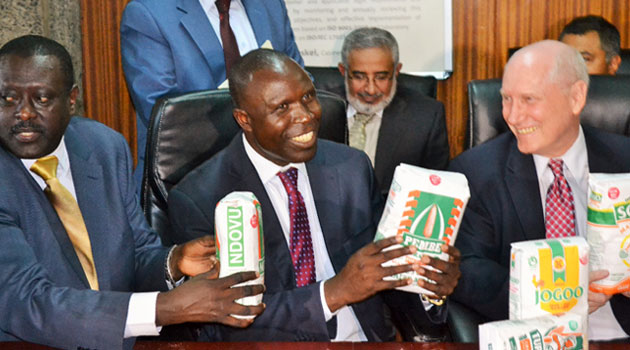
Agriculture Cabinet Secretary Willy Bett unveiling the subsidized Sh90 2Kg maize flour together with maize millers/FILE
NAIROBI, Kenya, Jun 24 – The maize shortage is not new to the country. But a number of factors combined to create a crisis that has become the hottest political issue pitting both sides of the divide.
A 2kg tin is now retailing at Sh150 in the maize rich regions and up to Sh180 in other areas, translating to Sh6,750 per 90kg bag, the highest in the country’s history.
At the core of the crisis is the Government’s failure to plan for the maize shortfall that was expected following below average harvest.
But the lack of foresight on the part of Government, on its own, would not have created the crippling maize flour shortage.
Abner Ingosi, an Agricultural Economist, who headed the Food Security division at the Ministry of Agriculture for 20 years, and now a FAO consultant, says a number of geopolitics factors combined to leave the Government with few options.
On average, Kenya produces 36 million bags of maize per year against a demand of 42 million, sourcing the deficit from neighboring Uganda and Tanzania.
Ingosi says the instability in South Sudan has interrupted the food production chain driving the price of maize to nearly Sh5,000 per 90Kg bag, against the Sh3,000 offered by the National Cereals Produce Board.
“Middlemen in Uganda and some parts of Kenya saw this opportunity and rushed to cash in by selling in this lucrative market,” Ingosi says, adding that farmers would have sold their maize in Kenya if NCPB offered Sh3,600.
When the action finally kicked in, it was too little, and in the wrong direction.
Ingosi says the Sh6 billion the government has pumped in the maize subsidy program would have been enough to mop up enough maize held by farmers in Kenya, and parts of Uganda – where Kenya gets 3 million bags to plug the shortfall.
The subsidy, which has brought down the price of the 2Kg maize flour from Sh182 to Sh90, aims to pacify consumers in what has become the hottest campaign issue pitting both sides of the divide.
“As it is, the subsidy is not sustainable in the long run, and is only benefitting millers” Ingosi adds.
The standard operating procedure in the event of a looming maize shortage is for Agriculture technocrats to send a cabinet memo requesting the national treasury to buffer national maize reserve.
It is not clear whether the memo was sent or ignored, but what is clear is that is experts had warned there would be a shortage as far back as February.
Meanwhile, Tanzania’s change of policy to sell maize flour instead of the cheaper maize bags locked out the 2.5 to 3 million bags Kenya buys from Tanzania.
Ingosi says the food situation might stabilize by September when farmers in South Rift and Western Kenya harvest maize.


































